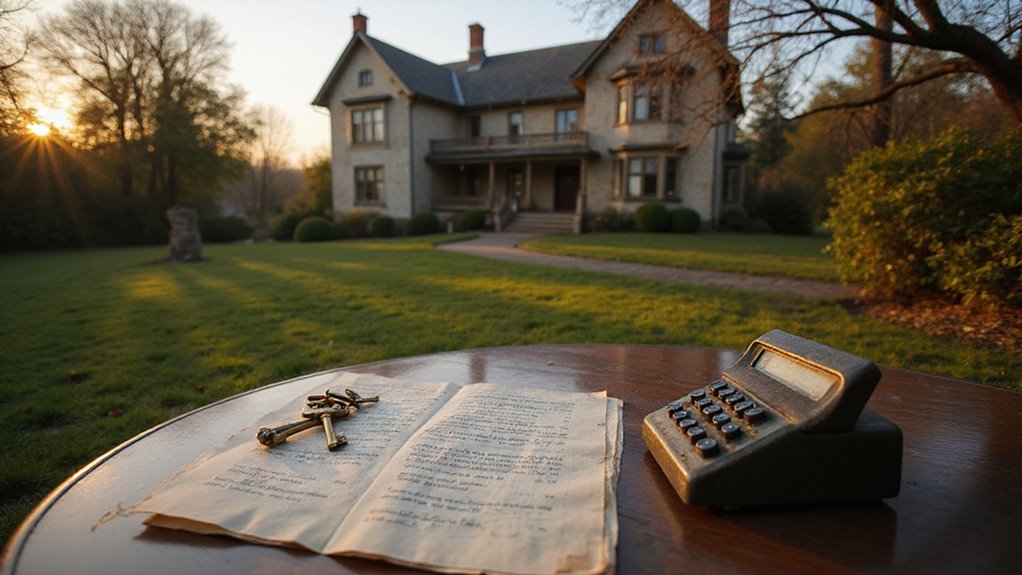Inheriting property brings both emotional and financial complexities into your life. While receiving property through inheritance might seem like a straightforward gift, the looming tax implications can create stress and uncertainty. Many beneficiaries worry about immediate tax burdens and potential financial strain. Fortunately, the tax system offers several advantages for those who inherit property.
Capital gains tax only applies when you sell inherited property, not when you receive it. Thanks to the stepped-up basis rule, you’re only taxed on gains above the property’s fair market value at inheritance, with federal rates between 0-20% based on your income.
This blog will explore every aspect of capital gains tax on inherited property, from calculations to exemptions.
Key Takeaways
- Federal capital gains tax rates range from 0% to 20% based on income bracket for long-term holdings.
- Tax applies only to gains above the stepped-up basis, which equals property’s value at inheritance date.
- Short-term gains (sold within one year) are taxed as ordinary income at rates of 10% to 37%.
- Primary residence exclusions allow single filers $250,000 and joint filers $500,000 in tax-free gains.
- State taxes vary by location, with some states treating capital gains as regular income.
What is capital gains tax on inherited property?

Capital gains tax applies only when you sell inherited property, not when you receive it. The tax rate ranges from 0% to 20% at the federal level, based on your income bracket. Your tax applies to the difference between the sale price and the property’s value at inheritance. This value becomes your new cost basis.
As a helpful tip, the stepped-up basis rule saves you money by eliminating tax on gains from before you inherited. State taxes vary, with some states treating these gains as regular income. Keep detailed records of the property’s value when inherited to calculate taxes correctly.
How does the stepped-up basis affect your tax liability?
A stepped-up basis reduces your tax liability by adjusting an inherited asset’s value to its market price at death. When someone inherits property worth $200,000 that was purchased for $50,000, the new tax basis becomes $200,000. The heir pays capital gains tax only on increases above this stepped-up amount.
As a result, heirs avoid paying taxes on value gained during the deceased owner’s lifetime. The IRS allows this tax benefit for most inherited assets, including real estate, stocks, and other investments. This provision helps families preserve wealth across generations.
How to Calculate Capital Gains Tax on Inherited Property?

To calculate capital gains tax on inherited property, you’ll need to follow a systematic approach that determines how much you owe when you sell. The process begins with establishing your stepped-up basis, calculating the difference between this basis and your sale price, and then applying the correct tax rate based on how long you’ve held the property. Understanding each component ensures you accurately report your gain and avoid overpaying taxes.
Determining the property’s basis
A property’s basis is its fair market value on the date of the previous owner’s death. The basis resets automatically to the value when inherited, known as stepped-up basis. A professional appraiser must verify this value through documentation. Most tax experts recommend keeping detailed records of this appraisal.
To support this process, proper paperwork will help during tax reviews. For example, when a home’s basis is $200,000, selling it for $250,000 creates a $50,000 taxable gain. Moreover, accurate records ensure smooth tax filing and protect against future IRS questions.
Calculating the gain amount
Subtract your asset’s basis (original purchase price or stepped-up value) from the sale price to determine your gain amount. The gain calculation formula is: Sale Price – Basis = Capital Gain. A proper calculation requires accurate records of all transactions and valuations. Keep all documentation, including purchase records, appraisals, and sale statements.
Furthermore, your gain type affects tax rates. Short-term gains from assets held under one year face higher taxes than long-term gains held longer. Careful record-keeping helps maximize tax benefits and prevents costly errors.
Applying the appropriate tax rate
Tax rates depend on how long you keep inherited property before selling it. Long-term capital gains rates of 0%, 15%, or 20% apply after holding property for more than one year. Short-term gains face higher ordinary income tax rates for sales within one year.
Federal tax brackets determine your exact rate, while Oklahoma treats all capital gains as regular income. Furthermore, homeowners can exclude up to $250,000 in gains from a primary residence sale. The stepped-up basis helps reduce your overall tax burden significantly.
Factoring in holding period classifications
The tax holding period for inherited property begins on the date of the original owner’s death. Long-term capital gains rates of 0%, 15%, or 20% apply to sales made more than one year after death. Short-term rates apply to sales within the first year, with taxes up to 37%. A stepped-up basis reduces taxable gains in all cases. Moreover, homeowners who live in the property for two years may qualify for capital gains exclusion benefits.
What are the current capital gains tax rates?
You’ll pay different capital gains tax rates depending on how long you hold the inherited property before selling. Short-term rates apply if you sell within one year of inheriting, taxing your gain as ordinary income at your regular tax bracket (10% to 37%). Long-term rates kick in after holding for more than one year, with federal rates of 0%, 15%, or 20% based on your taxable income thresholds.
Short-term capital gains rates
Short-term capital gains rates apply to profits from selling assets held for one year or less. These gains face taxes at ordinary income rates between 10% and 37%, based on your tax bracket.
The federal government considers inherited property sales within one year as short-term gains. A strategic approach involves holding assets longer. Long-term capital gains receive better tax treatment at 0%, 15%, or 20%.
Furthermore, state taxes vary by location, with places like Oklahoma taxing short-term gains as regular income. Smart investors often wait beyond the one-year mark to reduce their tax obligations.
Long-term capital gains rates
Long-term capital gains offer lower tax rates than short-term gains. A 0%, 15%, or 20% tax rate applies based on your income level and filing status. Single filers pay 0% on gains up to $44,625 and 15% from $44,626 to $492,300.
Married couples filing jointly benefit from higher thresholds: 0% up to $89,250 and 15% from $89,251 to $553,850. Above these limits, a 20% rate applies. The federal government provides these favorable rates on assets held over one year. However, Oklahoma residents must pay state taxes on gains at regular income rates.
Income thresholds and corresponding tax brackets
Tax rates on inherited property depend on your total yearly income. Lower earners pay less capital gains tax when selling inherited assets. The 2024 federal long-term capital gains rates follow three tiers. Single filers earning up to $47,025 pay 0%.
Income between $47,026 and $518,900 faces a 15% rate. Earnings above $518,900 trigger a 20% rate. Moreover, state taxes apply separately. Oklahoma residents must pay regular state income tax rates on capital gains. A tax professional can help determine your exact obligations.
When do you have to pay capital gains on inherited property?
You must pay capital gains tax when you sell inherited property, not when you receive it. The tax basis of inherited property adjusts to its fair market value on the date of the previous owner’s death. Tax rates depend on how long you keep the property before selling. A sale after one year qualifies for lower long-term capital gains rates.
For better tax outcomes, consider the timing of your property sale. Short-term sales face higher ordinary income tax rates. The stepped-up basis helps reduce your overall tax burden on inherited assets.
What tax exemptions and exclusions are available?

You can reduce or eliminate capital gains tax on inherited property through several exemptions and exclusions. The primary residence exclusion lets you exclude up to $250,000 ($500,000 for joint filers) of gains if you’ve lived in the property for two of the past five years. You’ll also want to consider 1031 exchanges for investment properties, loss deductions if you sell below the stepped-up basis, and any state-specific exemptions that apply to your situation.
Primary residence exclusion
Live in the inherited property for at least two years to qualify for primary residence exclusion. The IRS lets homeowners avoid substantial capital gains tax through this exemption. Your tax burden can drop significantly with proper timing.
Single tax filers may exclude up to $250,000 in capital gains from their taxable income. Joint filers receive an even larger benefit of up to $500,000 in exclusions.
The property must serve as your main residence. After establishing residency, the stepped-up basis combines with the exclusion to minimize taxes. This practical approach protects inherited wealth while meeting housing needs.
1031 exchanges for inherited investment property
Yes, you can do a 1031 exchange with inherited investment property to defer capital gains taxes. Your stepped-up basis becomes the property’s fair market value on the date of death. The IRS requires you to identify replacement property within 45 days after the sale. You must complete the entire exchange transaction within 180 days.
A successful exchange provides immediate tax benefits and maintains your investment portfolio’s growth potential. The process allows smart reinvestment of assets while preserving family wealth. Consider working with a qualified intermediary to ensure compliance with exchange rules.
Loss deductions
Loss deductions apply when you sell inherited property below its stepped-up basis value. The IRS allows capital loss claims on tax returns to reduce your tax burden. You can deduct losses up to $3,000 per year against regular income. For married couples filing separately, the limit is $1,500. Any excess losses roll forward to future tax years without expiration.
To maximize benefits, proper documentation of the stepped-up basis and final sale price is essential. Smart tax loss harvesting can offset other investment gains in the same tax year.
State-specific exemptions
Oklahoma offers no unique state capital gains exemptions on inherited property. The state treats all capital gains as regular income for tax purposes. Federal exemptions still apply to Oklahoma residents. Property owners can claim up to $250,000 in federal tax exclusions as single filers.
Moreover, married couples who file jointly qualify for up to $500,000 in exemptions. These federal benefits require living in the inherited property as a primary residence for two years within a five-year period. This strategic approach helps reduce overall tax obligations on inherited property sales.
How to Reduce Capital Gains Tax on Inherited Property?
You can reduce your capital gains tax burden on inherited property through several practical strategies. These include living in the home to qualify for the primary residence exclusion, timing your sale to maximize tax advantages, and offsetting gains with capital losses from other investments. You’ll also benefit from documenting capital improvements and considering installment sales to spread tax liability across multiple years.
Living in the property before selling
Moving into an inherited property before selling can significantly reduce your capital gains tax burden. You must live in the home as your primary residence for at least 2 years within a 5-year period before the sale. Single taxpayers can exclude up to $250,000 in capital gains, while married couples filing jointly can exclude up to $500,000.
To prove your residency status, keep records of utility bills and update your voter registration. Most importantly, make the property your genuine primary residence during this period. The tax benefits become available only after meeting these specific requirements.
Timing your sale strategically
Wait at least one year after inheritance before selling to minimize taxes. Long-term capital gains tax rates are lower than short-term rates on inherited property sales. The ideal time to sell depends on your current income level. A sale during a lower-income year can help you stay in a better tax bracket.
Smart timing involves understanding property values and market conditions in your area. The property’s stepped-up basis affects your potential tax obligations. A tax professional can guide you through optimal timing decisions.
Offsetting gains with losses
Tax losses can offset capital gains to reduce your overall tax burden. Short-term losses must match with short-term gains for optimal tax benefits. A strategic approach helps minimize capital gains taxes throughout the year. Your tax planning should align with current market conditions.
The IRS allows investors to carry forward up to $3,000 in excess losses against regular income each year. Proper documentation remains essential for tracking your adjusted tax basis. Your records should include purchase dates, sale prices, and relevant fees.
Professional tax guidance ensures compliance and maximizes potential tax advantages. Consider market timing and portfolio rebalancing needs before implementing loss-harvesting strategies.
Making capital improvements
Capital improvements boost property value and lower taxes on inherited real estate sales. Major upgrades like new rooms, electrical systems, or roofing will increase your cost basis and reduce capital gains tax. These substantial changes create permanent enhancements to the property.
Moreover, proper documentation matters greatly. Keep all receipts and contractor paperwork for tax calculations. Your strategic improvements benefit both you and future buyers. Finally, this approach preserves more sale proceeds for family or charitable purposes. A higher basis from documented improvements means less taxable profit at sale time.
Exploring installment sales
An installment sale divides property sale income into smaller payments over multiple years to reduce tax burden. The IRS allows sellers to pay capital gains tax only on payments received each year instead of the full amount upfront. This tax strategy creates manageable annual payments while lowering overall tax liability.
Moreover, this approach benefits both parties. Sellers maintain steady income streams and stay in lower tax brackets. Buyers gain access to property financing through reasonable payment terms. All installment payments must be reported yearly using IRS Form 6252 for compliance.
Conclusion
Understanding capital gains tax on inherited property helps you make informed decisions about selling or keeping the asset. When you have proper knowledge, you can better plan your tax strategy and minimize potential liabilities. Tax planning becomes easier when you know the rules and regulations that apply to inherited properties.
At Shawn Buys Houses, we specialize in helping Oklahoma property owners navigate their inheritance situations. We serve homeowners throughout Oklahoma City and surrounding areas in the state. Our team can guide you through the complex process of selling inherited property while considering tax implications.
If you’re looking to sell your inherited property in Oklahoma, we offer fair market evaluations and straightforward solutions. We help property owners across Oklahoma City understand their options and make confident decisions. Our expertise in local real estate ensures you get the best value while managing capital gains tax effectively.


